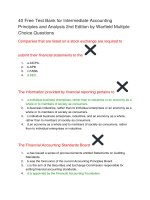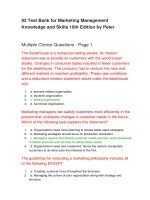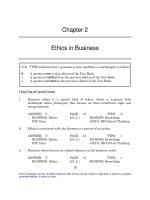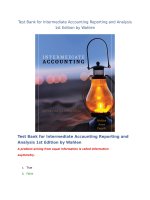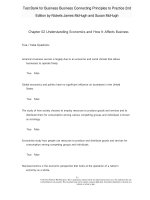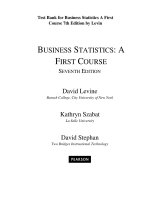Test bank for business law text and exercises 9th edition by miller
Bạn đang xem bản rút gọn của tài liệu. Xem và tải ngay bản đầy đủ của tài liệu tại đây (192.04 KB, 12 trang )
Test Bank for Business Law Text and Exercises 9th Edition by Miller
Full
file at />Name:
Class:
Date:
Ch 01: Introduction to the Law
1. Law consists of enforceable rules governing individuals and their society.
a. True
b. False
ANSWER: True
2. Laws and government regulations affect almost all business activities.
a. True
b. False
ANSWER: True
3. Many different laws may affect a single business transaction.
a. True
b. False
ANSWER: True
4. The study of business law does not involve an ethical dimension.
a. True
b. False
ANSWER: False
5. Being a small-business owner means that you will never have to take on the role of a human resources manager.
a. True
b. False
ANSWER: False
6. Ways to raise additional capital so that a business can grow is not a legal issue.
a. True
b. False
ANSWER: False
7. Whether management has to explicitly inform employees of their rights is a legal issue.
a. True
b. False
ANSWER: True
8. There are legal questions involved when choosing an appropriate business organizational form.
a. True
b. False
ANSWER: True
Copyright Cengage Learning. Powered by Cognero.
Full file at />
Page 1
Test Bank for Business Law Text and Exercises 9th Edition by Miller
Full
file at />Name:
Class:
Date:
Ch 01: Introduction to the Law
9. A small business owner is likely to face legal questions when determining ways to reduce business taxes.
a. True
b. False
ANSWER: True
10. To understand the law, it is important to understand its origins.
a. True
b. False
ANSWER: True
11. Stare decisis is a doctrine obligating judges to help persons who have failed to protect their own rights.
a. True
b. False
ANSWER: False
12. In a common law system, judges are obligated to follow the precedents established within their jurisdictions.
a. True
b. False
ANSWER: True
13. Courts do not depart from precedents.
a. True
b. False
ANSWER: False
14. Damages are a remedy at law.
a. True
b. False
ANSWER: True
15. Remedies in equity include injunctions.
a. True
b. False
ANSWER: True
16. In most states, the courts no longer grant “equitable” remedies.
a. True
b. False
ANSWER: False
Copyright Cengage Learning. Powered by Cognero.
Full file at />
Page 2
Test Bank for Business Law Text and Exercises 9th Edition by Miller
Full
file at />Name:
Class:
Date:
Ch 01: Introduction to the Law
17. The term common law refers to law that is common throughout the world.
a. True
b. False
ANSWER: False
18. Common law is a term for the laws that are familiar to most of us.
a. True
b. False
ANSWER: False
19. Constitutional law includes only the U.S. Constitution.
a. True
b. False
ANSWER: False
20. Whether a law is constitutional depends on its source.
a. True
b. False
ANSWER: False
21. A constitution sets forth a government’s general organization.
a. True
b. False
ANSWER: True
22. Statutory law includes the ordinances passed by cities.
a. True
b. False
ANSWER: True
23. Each state must adopt the uniform laws drafted by the National Conference of Commissioners on Uniform State
Laws.
a. True
b. False
ANSWER: False
24. Statutory law does not include county ordinances.
a. True
b. False
ANSWER: False
Copyright Cengage Learning. Powered by Cognero.
Full file at />
Page 3
Test Bank for Business Law Text and Exercises 9th Edition by Miller
Full
file at />Name:
Class:
Date:
Ch 01: Introduction to the Law
25. Statutory law includes state statutes.
a. True
b. False
ANSWER: True
26. Laws enacted by Congress become statutes.
a. True
b. False
ANSWER: True
27. Courts apply the law to a present set of facts.
a. True
b. False
ANSWER: True
28. Courts interpret what the rulemakers meant when a law was passed.
a. True
b. False
ANSWER: True
29. Rules issued by administrative agencies affect almost every aspect of a business’s operations.
a. True
b. False
ANSWER: True
30. Administrative law consists of the rules, orders, and decisions of the president.
a. True
b. False
ANSWER: True
31. Administrative law does not include local regulations.
a. True
b. False
ANSWER: False
32. Criminal law spells out the rights and duties that exist between persons.
a. True
b. False
ANSWER: False
Copyright Cengage Learning. Powered by Cognero.
Full file at />
Page 4
Test Bank for Business Law Text and Exercises 9th Edition by Miller
Full
file at />Name:
Class:
Date:
Ch 01: Introduction to the Law
33. Civil law has to do with wrongs committed against the public as a whole.
a. True
b. False
ANSWER: False
34. The basis of a civil law system is codified law.
a. True
b. False
ANSWER: True
35. International law governs relations among nations.
a. True
b. False
ANSWER: True
36. Overview, Inc., is a corporation engaged in the business of compiling, analyzing, and marketing data. With respect to
the firm’s officers, there is a link between the law and Overview’s
a. finance manager.
b. human resources manager.
c. marketing manager.
d. all of the choices.
ANSWER: d
37. Elroy and Fern are involved in a class action lawsuit. This is
a. a mock trial conducted as part of a class.
b. a judicial proceeding actively involving students.
c. a lawsuit in which a number of persons join together.
d. a moot court.
ANSWER: c
38. Congress enacts a statute. The Securities and Exchange Commission (a federal administrative agency) issues a rule.
The Finance Institutions Association (a private organization) issues instructions. Valley Bank posts a memo with
orders for its employees. Willy texts a co-worker about a recent news story. Sources of law include
a. instructions issued by private associations.
b. orders posted by employers.
c. rules issued by federal administrative agencies.
d. stories released by news agencies.
ANSWER: c
Copyright Cengage Learning. Powered by Cognero.
Full file at />
Page 5
Test Bank for Business Law Text and Exercises 9th Edition by Miller
Full
file at />Name:
Class:
Date:
Ch 01: Introduction to the Law
39. The state department of environmental quality issues a new rule, a county commission approves a new property tax
measure, and students at a public state law school publish their recent legal research. Sources of law do not include
a. measures approved by local governing bodies.
b. legal scholars’ research.
c. rules issued by state administrative agencies.
d. all of the choices.
ANSWER: b
40. Much of American law is based on
a. the English legal system.
b. the Spanish legal system.
c. the civil law of the Greeks.
d. Ancient Chinese law.
ANSWER: a
41. Kevin is a judge hearing the case of Local Dispatch Co. v. National Transport Corp. Applying the relevant rule of
law to the facts of the case requires Kevin to find previously decided cases that, in relation to the case under
consideration, are
a. as different as possible.
b. as similar as possible.
c. at odds.
d. exactly identical.
ANSWER: b
42. As a judge, Bonnie applies common law rules. These rules develop from
a. decisions of the courts in legal disputes.
b. regulations issued by administrative agencies.
c. statutes enacted by Congress and the state legislatures.
d. uniform laws drafted by legal scholars.
ANSWER: a
43. There are no precedents on which the court deciding the case Standard Resource Co. v. Topline Inventory, Inc.,
can base its decision. The court can consider, among other things,
a. the opinions of the friends and relatives of the judge.
b. the results of a poll of those in the courtroom.
c. public policy or social values.
d. none of the choices.
ANSWER: c
Copyright Cengage Learning. Powered by Cognero.
Full file at />
Page 6
Test Bank for Business Law Text and Exercises 9th Edition by Miller
Full
file at />Name:
Class:
Date:
Ch 01: Introduction to the Law
44. If Myra and Nick cannot resolve their dispute amicably, then it may become necessary to bring a lawsuit. This is
a. an order to do not do a certain act.
b. a criminal prosecution.
c. a judicial proceeding for the resolution of a dispute.
d. a type of regulation applied to a business.
ANSWER: c
45. Charles is a federal judge whose judicial decisions are part of case law, which does not include interpretations of
a. regulations created by administrative agencies.
b. constitutional provisions.
c. statutes enacted by legislatures.
d. parties’ subjective motives for engaging in litigation.
ANSWER: d
46. In the case of Retail Sales Corp. v. Trucking Delivery Co., the court may rule contrary to a precedent if the court
decides that the precedent
a. is incorrect or inapplicable.
b. is not in line with the judge’s personal values.
c. would lead to unintended consequences.
d. would not bring about the result the judge prefers.
ANSWER: a
47. In Benny v. City Car Dealership, a state supreme court held that a minor could cancel a contract for the sale of a
car. Now a trial court in the same state is deciding Dora v. Even Steven Auto Deals, Inc., a case with similar facts.
Under the doctrine of stare decisis, the trial court is likely to
a. allow the minor to cancel the contract.
b. disregard the Benny case.
c. order the minor to cancel the contract.
d. require the minor to fulfill the contract.
ANSWER: a
48. The means to enforce a right or compensate for a wrong is
a. a cornerstone.
b. a remedy.
c. jurisdiction.
d. stare decisis.
ANSWER: b
Copyright Cengage Learning. Powered by Cognero.
Full file at />
Page 7
Test Bank for Business Law Text and Exercises 9th Edition by Miller
Full
file at />Name:
Class:
Date:
Ch 01: Introduction to the Law
49. Federico and Gwen are involved in a court proceeding to enforce a right. This is
a. an action.
b. stare decisis.
c. an injunction.
d. a remedy.
ANSWER: a
50. In an action against Gina, Harry obtains a remedy. This is
a. an administrative agency’s enforcement of its rule.
b. a principle of the law derived from earlier court cases.
c. a statute enacted by a state legislature or Congress.
d. the legal means to recover a right or compensate for a wrong.
ANSWER: d
51. Stare decisis is best defined as
a. a doctrine under which judges follow established precedents.
b. the authority to decide a specific dispute.
c. a judicial proceeding to redress a wrong.
d. a situation giving a person a right to initiate a judicial proceeding.
ANSWER: a
52. James and Kay enter into a contract for the sale of a bicycle, but Kay later refuses to deliver the goods. James asks a
court to order Kay to perform as promised. Ordering a party to perform what was promised is
a. an equitable remedy.
b. an unenforceable demand.
c. an action.
d. beyond the court’s authority.
ANSWER: a
53. Each court has a certain jurisdiction. Jurisdiction is best defined as
a. a doctrine that follows established precedents.
b. the authority to decide a specific dispute.
c. a judicial proceeding to redress a wrong.
d. a situation giving a person a right to initiate a judicial proceeding.
ANSWER: b
Copyright Cengage Learning. Powered by Cognero.
Full file at />
Page 8
Test Bank for Business Law Text and Exercises 9th Edition by Miller
Full
file at />Name:
Class:
Date:
Ch 01: Introduction to the Law
54. In a suit against Klaus, Lucy obtains an injunction. This is
a. an order to do or not do a certain act.
b. a departure from precedent.
c. a payment of money.
d. the cancellation of a contract.
ANSWER: a
55. A constitution sets forth a government’s
a. limits, but not powers.
b. limits and powers.
c. neither limits nor powers.
d. powers, but not limits.
ANSWER: b
56. In a suit against Guy, Holly obtains an award of damages. This is
a. an order to do or not do a certain act.
b. the right to harm another.
c. a payment of money for a harm suffered.
d. the cancellation of a contract.
ANSWER: c
57. In the early King’s Court of England, a court of law could grant as a remedy only
a. damages.
b. an order to perform a contract as promised.
c. a judicial proceeding for the resolution of a dispute.
d. an injunction.
ANSWER: a
58. If a provision in the California state constitution conflicts with a provision in the U.S. Constitution
a. neither provision applies.
b. both provisions apply equitably.
c. the state constitution is supreme within the state’s borders.
d. the U.S. Constitution is supreme.
ANSWER: d
Copyright Cengage Learning. Powered by Cognero.
Full file at />
Page 9
Test Bank for Business Law Text and Exercises 9th Edition by Miller
Full
file at />Name:
Class:
Date:
Ch 01: Introduction to the Law
59. The Uniform Commercial Code provides a set of rules governing
a. commercial transactions.
b. judicial proceedings.
c. legislative procedures.
d. executive edicts.
ANSWER: a
60. The Montana legislature enacts a state law that violates the U.S. Constitution. This law can be enforced by
a. no one.
b. the federal government only.
c. the state of Montana only.
d. the United States Supreme Court only.
ANSWER: a
61. The Uniform Commercial Code facilitates commerce
a. among the states.
b. between the states and the federal government.
c. in countries that were once colonies of Great Britain.
d. in international markets.
ANSWER: a
62. The Consumer Product Safety Commission is a government agency that issues rules, orders, and decisions. The Ohio
state legislature enacts statutes. The Wayne County Board and the Midford City Council enact ordinances.
Administrative law includes
a. all laws that affect business operations.
b. the rules, orders, and decisions of a government agency.
c. statutes enacted by a state legislature.
d. ordinances enacted by a county and a city.
ANSWER: b
63. The Uniform Commercial Code has been adopted, at least in part, in
a. all states.
b. forty-five states.
c. thirty-five states.
d. no state.
ANSWER: a
Copyright Cengage Learning. Powered by Cognero.
Full file at />
Page 10
Test Bank for Business Law Text and Exercises 9th Edition by Miller
Full
file at />Name:
Class:
Date:
Ch 01: Introduction to the Law
64. The Bay City Planning Department, the Coastal County Zoning Commission, the Delaware Environmental Quality
Agency, and the U.S. Bureau of Land Management issue regulations. These rules constitute
a. administrative law.
b. case law.
c. constitutional law.
d. statutory law.
ANSWER: a
65. Criminal acts are prohibited by
a. local statutes only.
b. state statues only.
c. federal statutes only.
d. local, state, or federal statutes.
ANSWER: d
66. Criminal law has to do with
a. the prosecution of private individuals by other private individuals.
b. the prosecution of public officials by private individuals.
c. the relief available when a person’s rights are violated.
d. wrongs committed against the public as a whole.
ANSWER: d
67. The classification of law that concerns the rights and duties that exist between persons and between citizens and their
government is
a. criminal law.
b. civil law.
c. constitutional law.
d. federal law.
ANSWER: b
68. National law is
a. law that pertains to a particular nation.
b. law that has an extraterritorial effect.
c. all law that is applied within a nation’s courts, including international law and the law of another country.
d. federal law, as opposed to state law.
ANSWER: a
Copyright Cengage Learning. Powered by Cognero.
Full file at />
Page 11
Test Bank for Business Law Text and Exercises 9th Edition by Miller
Full
file at />Name:
Class:
Date:
Ch 01: Introduction to the Law
69. To benefit from international trade, individual nations agree to be governed by
a. international law.
b. the Uniform Commercial Code.
c. none of the choices.
d. the laws of other nations.
ANSWER: a
70. International law must accommodate the need of each nation to be the final authority over
a. other nations.
b. international markets.
c. its own affairs.
d. all individuals.
ANSWER: c
71. The National Rights Council, a nonprofit organization, files a suit against the U.S. Department of Justice (DOJ),
claiming that a certain federal statute the DOJ is empowered to enforce conflicts with the U.S. Constitution and with
a state constitution. In each situation, which source of law has priority?
ANSWER: The U.S. Constitution is the supreme law of the land. A law in violation of the Constitution, no matter
what its source, will be declared unconstitutional and will not be enforced. Thus, the federal statute does
not have priority over the Constitution. The federal statute would have priority over the state constitution,
however, because under the U.S. Constitution, when there is a conflict between a federal law and a state
law, the state law is rendered invalid.
72. In a dispute between Cloud Computing Corporation and Digital Enterprises, Inc., the court applies the doctrine of
stare decisis. What is this doctrine? What does this doctrine have to do with the American legal system?
ANSWER: In a common law legal system, past judicial decisions are binding in current disputes with similar facts.
This feature of the common law, which is the basis of the American legal system, is unique because,
unlike the law in other legal systems, it is judge-made law. Within the common law system, when possible,
judges attempt to be consistent and to base their decisions on the principles suggested by earlier cases.
The body of principles and doctrines that form the common law emerged over time as judges applied the
principles announced in earlier cases to subsequent legal controversies.
The practice of deciding cases with reference to former decisions, or precedents—the cornerstone of the
American legal system—is called the doctrine of stare decisis. Under this doctrine, judges are obligated
to follow the precedents established within their jurisdictions. This helps courts to be more efficient, and
makes the law more stable and predictable.
Copyright Cengage Learning. Powered by Cognero.
Full file at />
Page 12
